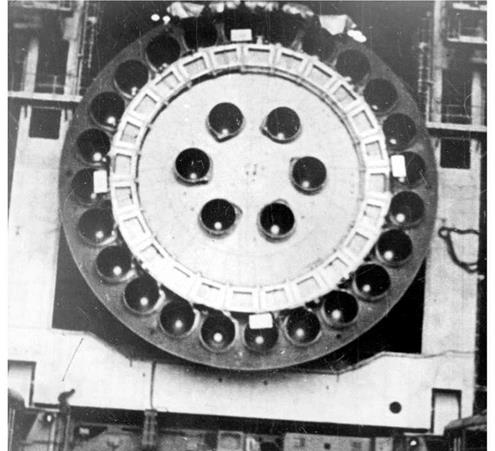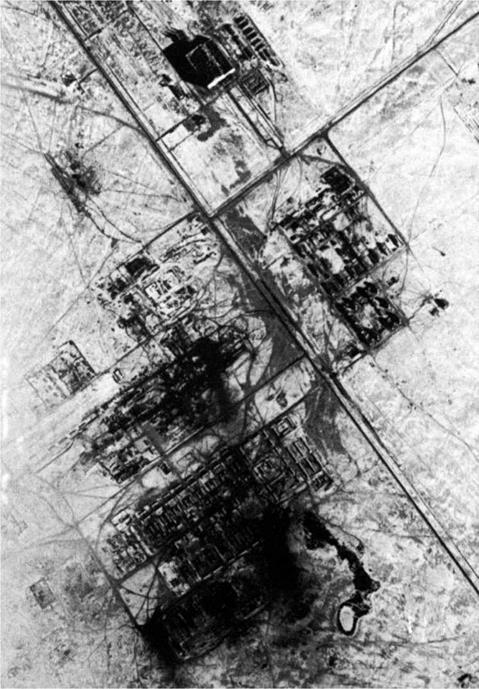BUILDING THE N-l
The revised 95-tonne N-1 design was frozen and signed off by Korolev on 25th December 1964. There was far from unanimity on the design and several knowledgeable engineers insisted that the original 75 tonne N-1 design had been pushed beyond its natural limits, with a consequent risk of failure. The piping was a plumber’s nightmare. The launch mass was an enormous 2,700 tonnes. Although the N-1 was to be the same size as America’s Saturn V, its less efficient fuels produced a smaller payload. Even though the N-1 would follow a profile identical to Saturn V and Apollo, N-1 had the capacity to send only two cosmonauts into lunar orbit and only one down to the surface.
Although the project had first been mooted in 1956 and approved in 1960, significant resources did not begin to flow into the project until late 1964. Now the N-1 had to catch up for time lost. In his effort to do so, Korolev took two important decisions: [4]
|
Spurring people on – Korolev in 1964 |
Korolev’s philosophy was to fly rockets at the first available opportunity, so that whatever flaws might be there revealed themselves early on during a rocket’s development (most rockets were happy to oblige). Under the intense pressure to get the N-1 programme under way, Sergei Korolev and his successor Vasili Mishin minimized the ground-testing segment, a mistake the Americans did not make with the Saturn V (nor the Chinese in their programme). Korolev sometimes said in his defence that the government would not pay for proper ground-testing facilities and they would have held him up too much. Khrushchev does not agree and says that the government would never have denied Korolev proper ground-testing facilities had he asked for them – ‘especially a chief designer of Korolev’s calibre’ [8]. Chelomei’s Proton, though, presents a counter-argument. It was extensively ground-tested, but its flight record until 1972 was no better than some of Korolev’s rockets.
|
The N-1 engine system |
In an effort to compensate for possible first-stage problems, a special control system was introduced by Vasili Mishin. There was a real danger that the failure of an individual engine could jeopardize the whole mission. Accordingly, Mishin designed an engine operation control system, called KORD (Kontrol Roboti Dvigvateli) in Russian, which would shut down any badly performing engine automatically and a good engine immediately opposite, so as to preserve the symmetry of the vehicle’s thrust. KORD would also re-programme the burn so as to make up for the lost thrust. The system could tolerate the loss of four first-stage and two second-stage engines and still achieve orbit.
Compared with the Gas Dynamics Laboratory, Kuznetsov’s OKB-276 was poorly resourced and lacked any rocket engine testing facilities when it was awarded the contract for the moon rocket. Korolev was adamant about all-up testing and would never launch dummy upper stages, which he regarded as wasteful (the
Americans took a different view). Korolev argued that there was a high degree of commonality between all the NK engines and if they were tested properly individually, they should work in stages. The KORD system should be able to cope with any problems arising and the redundancy built in should protect against catastrophic failure. Against that, all engine designers will argue that exhaustive ground-testing will reveal old flaws, new flaws and be worth the investment. The preparation of the N-1 was such a huge event that the programme could not survive repeated catastrophic failures (indeed, it didn’t).
There were no ground tests of all the first-stage engines together, with or without the KORD system. But it is wrong to say that there were no ground tests at all. To the contrary, the main rocket-testing centre in the Soviet Union, at Zagorsk (now Sergeev Posad) was used for otherwise exhaustive engine tests over 1967-8. The first engine tests began in September 1967. The NK engines were erected on stands and tested for long periods. The second, third, fourth and fifth stages were tested as stages there, but not, of course, the full first stage. Granted the commonality between the engines, they may reasonably have hoped that mastering the first stage should not present serious difficulties. By the time of the first flight of the N-1, the engines had been tested for 100,000 sec on the ground.
At last, with the government resolution of August 1964, there was a sudden surge of momentum. Construction of the first N-1 pad began the next month in September. After blueprints were agreed on 30th December 1964, the government issued a decree for the construction of 16 N-1 rockets on 26th January 1965. Construction of a second, adjacent pad began in February 1966. The first N-1 hardware appeared in Baikonour in November 1966. The first pad was completed in August 1967. A mockup of the N-1 was rolled out there on 25th November 1967. This was a wise precaution, for there were many problems in trying to integrate the model with the launch pad and its fuelling systems. These took a year to sort out. Two weeks later, on 11th December, it was spotted by an American Corona photoreconnaissance satellite. The model threw a shadow across a quarter of a mile that late afternoon and set alarm bells ringing in Washington DC [9].
These pads were the largest project ever made at Baikonour. Concrete pads were built, with flame trenches gouged out of the ground underneath. Two pads were built, 500 m apart. Each had a 145 m tall rotating servicing tower and 42 m deep flame trenches. Propellants were supplied to the towers by a fuel area in between the two. To get the N-1 rocket to the pad, two railway lines were constructed from the hangar. Two diesel engines moved the empty N-1 down to the pad in parallel. Once it reached the pad, a giant crane erector moved the rocket to the vertical. The N-1 was assembled in what must have been the largest structure built at Baikonour to that point, the final assembly building. This was a huge hangar 240 m long and 190 m wide, its height ranging from 30 m to 60 m, with two high bays and three low bays [10].
The promised Lunar Exploration Council or LEK now set about its business and the N-1 passed a further design review under Keldysh on 16th November 1966. The government resolution on the moon programme of 4th February 1967 laid down a schedule for the first twelve flights of the N-1. The schedule was ambitious, to the point
|
N-l pads under construction, as seen by American intelligence |
of being wholly unrealistic. The plan specified an unmanned test in September 1967 (about the same time as the American Saturn V), leading to a manned lunar landing in September 1968.

 |
 |
 |
The first complete N-1 rocket began construction in Samara in February 1967. Two flight models reached an advanced stage by September 1967. The first N-1 was rolled out to the pad on 7th May 1968. By then, the first N-1 launch was scheduled for later that year. Cracks were then spotted in the first-stage tanks and the whole rocket was removed over 10th-12th June. This was quite a setback to the schedule and meant that the N-1 would not fly in 1968. To continue the momentum of the programme, a mockup N-1 was at the pad from August to October for launchpad tests. To the snooping American satellites, this provided a prolonged opportunity to photograph the target during a period of good sunlight and enable the Americans to model the launcher. But even with their advanced photography, from their altitude of 150 km, the difference between a mockup and the real thing may not have been obvious.
Fifth stage (block D)
![]()
![]()
 |
 |
Engine
Fuel
Few people have made direct comparisons between the Saturn V and the N-1. One who has is Berry Sanders [11]. His findings were that:
• The Saturn V had a steeper trajectory than the N-1, which rolled on its side sooner.
• The Saturn V was bigger and more powerful. The first stage of the Saturn V had a fuelled weight of 2,244 tonnes, compared with the 1,875 of the N-1. On the Saturn V, the main effort at lifting was done by the hydrogen-powered second stage, while on N-1 the burden was spread evenly between the three stages. Hydrogen gave the Americans a definite advantage.
• Saturn V could put 117 tonnes into orbit, compared with 95 tonnes for the N-1. However, the N-1 paid a considerable penalty for launching into a 51° orbit from a launch site as far north as Baikonour. Had the N-1 been launched from Cape Canaveral, the N-1 could have put 104 tonnes into orbit.
Evaluating the N-1 is a difficult undertaking. At first sight, it was a disastrous rocket, for it exploded four times out of four. By comparison, the Saturn V was an engineer’s dream, for it flew 13 times and succeeded 13 times (not that all launches were incident – free, but they all made it into orbit). After the programme was over, Kuznetsov continued work on his NK-33 engine at his own expense. He decided on a duration test of 20,360 sec on a test stand. It ran perfectly. Fourteen engines logged up to 14,000 sec in other tests. Chief designer Mishin considered it the best rocket engine ever made.
Kuznetsov’s engineers received the orders from Valentin Glushko to destroy the engines in 1974, but they could not bring themselves to do it. Instead, they hid them in a shed and put a big nuclear skull-and-crossbones warning sign over them, believing that would keep prying eyes away, which it did. There the engines gathered dust for 20 years and were rediscovered, almost by accident. Visiting American engineers saw
them on a visit to Samara and could not believe their eyes: hundreds of moon rocket engines in mint order! The American Aerojet company at once bought 90 of them for $450 million and in 1995 sent them off to its Sacramento, CA plant for testing and evaluation. They worried if there would be any problems in relighting motors that had been in storage since 1974. They ran two tests – of 40 sec and 200 sec – and there were not. Aerojet’s evaluation of the engine found that it could deliver over 10% more performance than any other American engine and enthused over its simplicity, lightness and low production costs. The hydrogen upper stage, originally planned for a later version of the N-1, became the upper stage of the Indian GSLV launch vehicle more than 25 years later.
The basic problem with the N-1 was the lack of thorough ground-testing. It was here that the much smaller resources of the Soviet Union and poor organization told against its moon programme. Rocket designers continued to underestimate the problems associated with the integration of engines on stages and the resulting problems of vibration, sound, fuel flow and control. Testing engines individually, however good they are, can be a poor guide as to how they behave collectively. Even where this is done, there is no guarantee of success, as the thoroughly prepared Proton proved. The world’s space programmes are full of histories of rockets that proved extraordinarily difficult to tame: the American Atlas and Centaur, the Chinese Feng Bao, Europe’s Europa and India’s SLV. Even programmes that have built on the experience of all that has gone before can suffer nasty surprises, like Europe’s Ariane. Having said all that, it is hard to believe that thorough ground-testing would not have stacked the odds much more in favour of the N-1. The four flight failures all had their roots in problems that could have been identified in thorough ground-testing. The real issue is not that the N-1 was a bad rocket, but that the Saturn V was so exceptionally good.
Were the rival UR-700 and R-56 proposals better? The UR-700 scheme developed by Chelomei might well have worked. In promising exhaustive ground-testing first, Chelomei rightly hit on one of the great weaknesses of Korolev’s approach. Chelomei was a superb designer but he was also slow: his Almaz space station was approved in 1964 but he did not get it ready for its first flight until 1973 and there is no reason to believe he could have built his moon rocket any sooner.
In retrospect, the Russian moon programme might have been better to go for the large RD-270 engines which Glushko began to develop. Korolev probably correctly judged that the development of the RD-270s would have required an extensive range of ground facilities and taken too long. With time against him, he calculated that it was better to go with a tried-and-tested system, even if it meant 30 engines. Korolev was always battling time to get his N-1 airborne, struggling with government departments for budgets and travelling endlessly to Samara, Leningrad and Baikonour to keep things moving. Korolev may have reckoned that he had to be lucky with only one successful N-1 launch and he would then get, from the political bosses, the resources he needed to bring the project to fruition.
If the N-1 had eventually worked, then a Russian moon landing would definitely have been possible at some stage. Alternatively, if the Russians had decided not to pursue a moon landing, then they would have had available to them a large rocket able
to launch a very big space station. Several such designs were even sketched during this period. Instead of the smaller, Mir-class space station of 1986-2001, the Russians would have been able to put in orbit a large space station block long before 1980, something as large as the International Space Station. The cancellation of the N-1 not only marked the effective end of the Soviet man-on-the-moon programme but had a profound effect on the subsequent development of cosmonautics.













